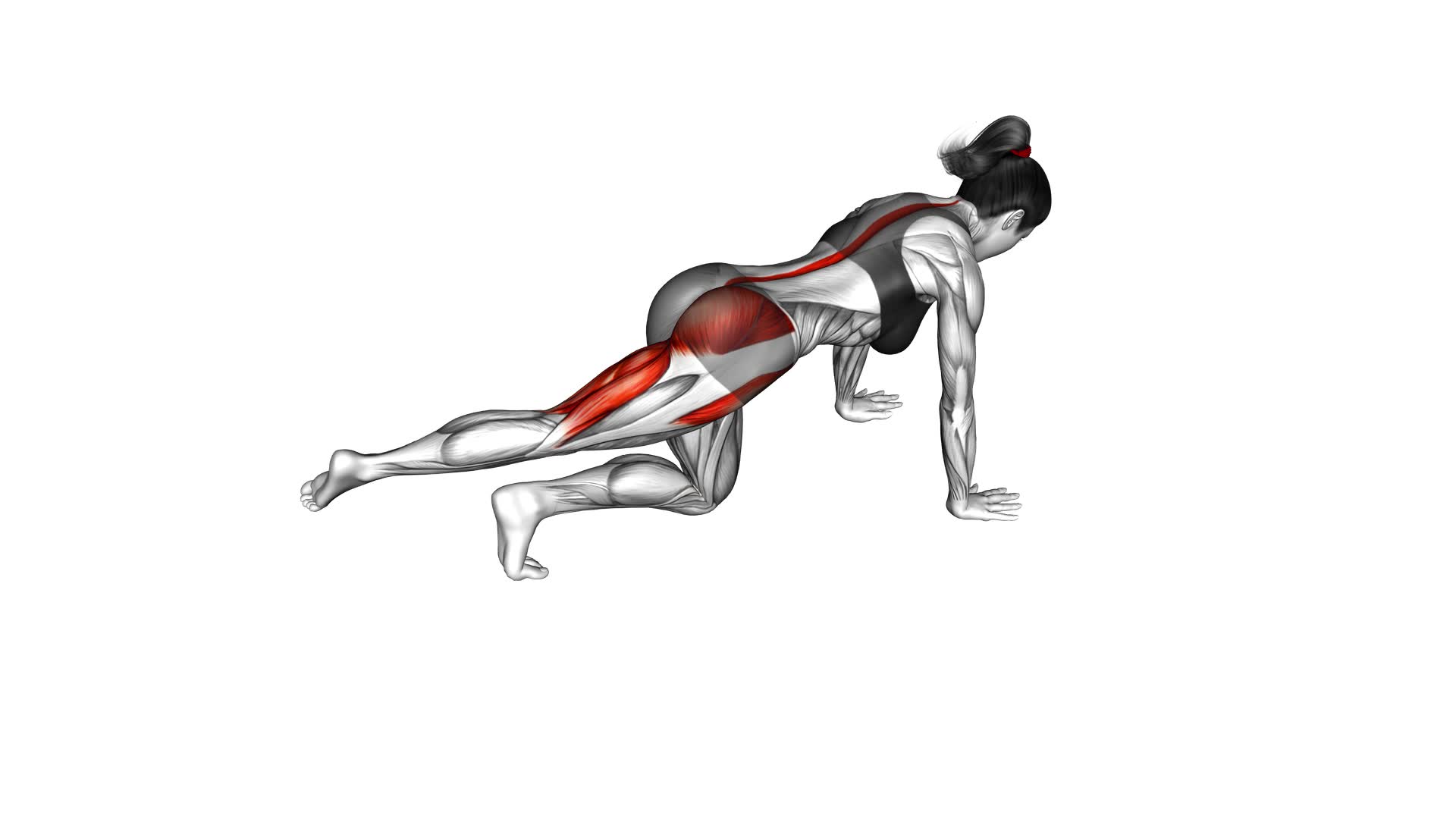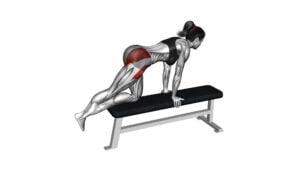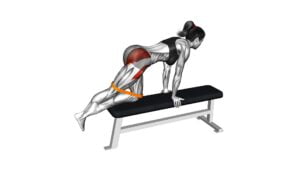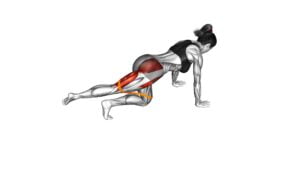Kneeling Leg Half Circle (female) – Video Exercise Guide & Tips

Get ready to tone and strengthen your legs with the Kneeling Leg Half Circle exercise. In this video exercise guide, we'll show you the proper form and technique, as well as modifications for different fitness levels.
Watch This Exercise Video
Avoid common mistakes and learn tips for incorporating this exercise into your fitness routine. Whether you're a beginner or an experienced fitness enthusiast, this exercise is a great addition to your leg workout.
Let's get started!
Key Takeaways
- The kneeling leg half circle exercise strengthens and stretches leg muscles while targeting glute muscles.
- It improves balance and enhances body stability.
- The exercise can be modified for different fitness levels, such as using a resistance band for support or performing seated on a stability ball or bench.
- Proper form and technique, such as engaging core muscles, maintaining proper alignment, and avoiding excessive rounding or arching of the back, are important for effective and safe execution of the exercise.
Benefits of the Kneeling Leg Half Circle Exercise
To understand the benefits of the Kneeling Leg Half Circle Exercise, you need to know how it can strengthen and stretch your leg muscles. This exercise is excellent for improving balance and targeting the glute muscles. By performing the Kneeling Leg Half Circle Exercise, you can enhance the stability of your body, helping you to stay steady on your feet during daily activities.
This exercise specifically targets the glute muscles, which are essential for maintaining proper posture and stability. The movement involved in this exercise also helps to stretch and lengthen the muscles in your legs, improving flexibility.
By incorporating the Kneeling Leg Half Circle Exercise into your workout routine, you can reap the benefits of improved balance and strengthened glute muscles. This exercise can be done with minimal equipment and can easily be modified to accommodate different fitness levels.
Now that you understand the benefits of this exercise, let's move on to discussing the equipment needed to perform the Kneeling Leg Half Circle Exercise effectively.
Equipment Needed for the Exercise
Now let's talk about what equipment you'll need to perform the Kneeling Leg Half Circle Exercise effectively. Don't worry, you won't need any fancy or expensive equipment for this exercise. Here's what you'll need:
- Mat or soft surface: To provide cushioning and support for your knees and elbows, it's recommended to use a mat or a soft surface. This will help prevent discomfort and potential injuries while performing the exercise.
- Resistance band: Adding a resistance band to your Kneeling Leg Half Circle Exercise can increase the challenge and intensity. By placing the band around your thighs, you'll engage your muscles even more, making the exercise more effective.
- Stability ball: If you want to add an extra element of instability and challenge to the exercise, you can use a stability ball. By placing your palms on the ball instead of the floor, you'll activate your core muscles even further, enhancing the benefits of the exercise.
Proper Form and Technique for the Exercise
Ensure correct form and technique when performing the Kneeling Leg Half Circle Exercise to maximize its effectiveness and prevent injuries.
Proper technique is crucial to getting the most out of this exercise. One common mistake is allowing the back to round or arch excessively. To avoid this, engage your core muscles by pulling your belly button towards your spine, and maintain a neutral spine throughout the movement.
Another mistake is rushing through the exercise. Take your time and focus on controlled movements to target the correct muscles. It's important to keep the supporting leg stable and grounded throughout the exercise. Avoid shifting your weight or allowing the knee to cave inwards.
Keep your shoulders relaxed and down, and avoid hunching or shrugging. Lastly, maintain proper alignment by keeping your hips squared and facing forward. This will help ensure that you're engaging the correct muscles and avoiding unnecessary strain.
Modifications and Progressions for Different Fitness Levels
Now let's talk about the modifications and progressions you can make for different fitness levels when performing the kneeling leg half circle exercise.
If you're a beginner, there are specific modifications that can help you build strength and stability before advancing to more challenging variations.
On the other hand, if you're more advanced, there are progression techniques that can take this exercise to the next level, challenging your muscles even further.
Beginner Modifications Explained
To progress at your own pace and adapt to your fitness level, incorporate beginner modifications for the kneeling leg half circle exercise. These modifications will help you build strength and improve your technique while avoiding injury.
Here are three beginner modifications to consider:
- Start with a smaller range of motion: Instead of attempting a full leg circle, begin by performing smaller circles with your leg. This will allow you to maintain proper form and engage the correct muscles without straining or overexerting yourself.
- Use a resistance band: If you find it difficult to lift your leg without support, try using a resistance band. Attach one end of the band to a sturdy anchor point and place the other end around your foot. The band will provide assistance as you perform the leg circles.
- Focus on stability: Instead of performing the exercise on your knees, try doing it while seated on a stability ball or a bench. This will provide additional support and help you maintain balance throughout the movement.
Advanced Progression Techniques
To continue progressing and challenging yourself in the kneeling leg half circle exercise, you can incorporate advanced modifications that cater to different fitness levels.
These modifications are designed to further strengthen your core, improve balance, and enhance flexibility.
One advanced progression technique involves adding resistance by using ankle weights or resistance bands. This increases the intensity and workload on your muscles, making the exercise more challenging.
Another modification is to perform the exercise on an unstable surface, such as a balance board or a foam pad. This forces your body to engage more muscles for stability, thereby improving overall strength and coordination.
Additionally, incorporating injury prevention techniques, such as proper form and alignment, is crucial when performing advanced variations. Remember to listen to your body and consult with a fitness professional if needed to ensure safe and effective execution of these advanced techniques.
Common Mistakes to Avoid During the Exercise
Avoid these common mistakes while performing the kneeling leg half circle exercise to ensure proper form and technique. Here are some key points to keep in mind:
- Maintaining proper alignment: It's crucial to keep your body in the correct position throughout the exercise. Avoid leaning forward or backward, and make sure your spine remains neutral.
- Engaging the core muscles: Remember to activate your core muscles to stabilize your body during the movement. This will help prevent excessive strain on your lower back and maintain balance.
- Controlling the movement: Avoid rushing through the exercise. Instead, focus on controlling the leg movement and maintaining a slow and controlled pace. This will maximize the effectiveness of the exercise and reduce the risk of injury.
Tips for Incorporating the Kneeling Leg Half Circle Exercise Into Your Fitness Routine
To incorporate the kneeling leg half circle exercise into your fitness routine, focus on proper form and technique. This exercise primarily targets the glutes, hamstrings, and hip flexors. However, by incorporating variations, you can target different muscle groups and add variety to your workout.
One variation is to add ankle weights or resistance bands to increase the intensity of the exercise. This will challenge your muscles even more and help you build strength and endurance.
Another variation is to perform the exercise on a stability ball or BOSU ball. This will engage your core muscles and improve your balance and stability.
To target your inner thighs, you can place a small ball between your knees and squeeze it as you perform the exercise. This will activate your adductor muscles and help tone and strengthen your inner thighs.
Remember to always listen to your body and start with lighter weights or resistance bands if you're a beginner. Gradually increase the intensity as you get stronger and more comfortable with the exercise.
Incorporating these variations won't only challenge your muscles in different ways but also keep your workout routine exciting and effective.
Frequently Asked Questions
How Many Repetitions and Sets Should I Do for the Kneeling Leg Half Circle Exercise?
For the kneeling leg half circle exercise, you should aim for 8-12 repetitions per set. Start with 2-3 sets and gradually increase as you get stronger. Remember to listen to your body and take breaks if needed.
To add variation, you can try using ankle weights or resistance bands to increase the intensity.
It's important to maintain proper form throughout the exercise to avoid any injuries.
Can I Do the Kneeling Leg Half Circle Exercise if I Have Knee Pain?
If you have knee pain, it's important to listen to your body and avoid exercises that aggravate it. The kneeling leg half circle exercise may not be suitable for you in this case.
However, there are alternative exercises and modifications available that can target the same muscles without putting stress on your knees.
It's always best to consult with a fitness professional or physical therapist to find the best options for your specific needs.
Is the Kneeling Leg Half Circle Exercise Suitable for Beginners?
The kneeling leg half circle exercise is suitable for beginners. There are modification options available to make it easier for you.
Incorporating this exercise into your workout routine has numerous benefits. It strengthens your core, glutes, and legs while improving your balance and flexibility.
By gradually increasing the difficulty level, you can progress and challenge yourself over time.
Remember to listen to your body and consult a professional if you have any concerns or physical limitations.
Can I Do the Kneeling Leg Half Circle Exercise Without Any Equipment?
Yes, you can definitely do the kneeling leg half circle exercise without any equipment. This exercise is great because it targets your glutes, hips, and core muscles.
If you don't have any equipment, you can easily modify the exercise by using your own body weight. Alternatives to this exercise include other leg exercises that work similar muscle groups, such as lunges or squats.
The benefits of the kneeling leg half circle exercise include improved lower body strength and stability.
What Muscles Does the Kneeling Leg Half Circle Exercise Target?
The kneeling leg half circle exercise targets multiple muscles in your lower body, including your glutes, hamstrings, quads, and hip flexors. By engaging these muscles, you can improve overall lower body strength and stability.
This exercise also helps with balance and flexibility. To target specific muscles or accommodate different fitness levels, you can try variations like adding ankle weights or using a resistance band.
Remember to always maintain proper form and listen to your body's limitations.
Conclusion
Incorporating the kneeling leg half circle exercise into your fitness routine can provide numerous benefits. It helps improve leg strength, flexibility, and balance.
This exercise can be modified and progressed to suit different fitness levels. It's important to maintain proper form and technique to avoid common mistakes.
By following the tips and using the right equipment, you can maximize the benefits of this exercise and enhance your overall fitness.

Author
Years ago, the spark of my life’s passion ignited in my mind the moment I stepped into the local gym for the first time. The inaugural bead of perspiration, the initial endeavor, the very first surge of endorphins, and a sense of pride that washed over me post-workout marked the beginning of my deep-seated interest in strength sports, fitness, and sports nutrition. This very curiosity blossomed rapidly into a profound fascination, propelling me to earn a Master’s degree in Physical Education from the Academy of Physical Education in Krakow, followed by a Sports Manager diploma from the Jagiellonian University. My journey of growth led me to gain more specialized qualifications, such as being a certified personal trainer with a focus on sports dietetics, a lifeguard, and an instructor for wellness and corrective gymnastics. Theoretical knowledge paired seamlessly with practical experience, reinforcing my belief that the transformation of individuals under my guidance was also a reflection of my personal growth. This belief holds true even today. Each day, I strive to push the boundaries and explore new realms. These realms gently elevate me to greater heights. The unique combination of passion for my field and the continuous quest for growth fuels my drive to break new ground.







